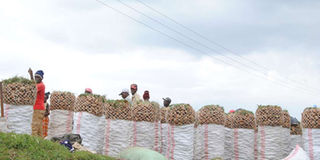Why excess or little light is bad for stored Irish potatoes

Potatoes packed in bags ready for transportation in Molo. Exposing potato seeds to too much light encourages sprouting of the shoots while still under storage. PHOTO | JOHN NJOROGE | NATION MEDIA GROUP
What you need to know:
- Always use certified seeds from reliable sources such as KALRO.
- The International Potato Center (CIP) notes that 99 per cent of all potato seeds planted in Kenya are not certified.
- Poor agricultural practices such as late weeding and ridging, poor fertilisation and manure application, poor diseases and pests control also contribute to low yields.
- Exposing potato seeds to too much light encourages sprouting of the shoots while still under storage, thus sale of such potatoes becomes a challenge.
Irish potato (Solanum tuberosum L) is the third most important and widely consumed food crop after rice and wheat worldwide.
In Kenya, it is the most important staple crop after maize. It is high in protein, calcium and is also a good source of low-fat carbohydrates.
In addition, potato farming is a source of employment and income to many farmers in Kenya. Thus, it plays a key role in food security.
However, there are challenges that affect the profitability of this crop leading to losses when the crop is in the field or after harvest.
This article identifies the losses and offers remedies.
In Kenya, there has been notable increase in potato production over the years, but the rise is mainly in the acreage and not in the yield.
The first challenge is poor quality seeds and second diseases. There are over 60 potato varieties in Kenya but the most popular are Nyayo, Tigoni, Shangi Tana, and Kimande.
Majority of these seeds are selected by farmers from previous harvests (self-supply) and this poses a challenge as they are prone to seed degeneration and pass on diseases.
The International Potato Center (CIP) notes that 99 per cent of all potato seeds planted in Kenya are not certified. In addition, farmers prefer to use the smallest tubers as seeds mainly because commercial potato middlemen discriminate against small tubers.
However, small tubers are prone to disease attack and produce few tubers. This in turn reduces productivity.
To avert this, farmers should use certified seeds from reliable sources such as Kenya Agricultural and Livestock Research Organisation (Kalro).
POOR AGRICULTURAL PRACTICES
If using self-supplied seeds, one should select healthy and relatively bigger seeds that are less prone to diseases.
Late bright is the most dangerous disease affecting potatoes worldwide and it destroys leaves, stems and tubers.
Other diseases include bacterial wilt and potato blackleg. These diseases are caused by close rotations and continued mono-cropping.
Poor agricultural practices such as late weeding and ridging, poor fertilisation and manure application, poor diseases and pests control also contribute to low yields.
To counter this, use of improved varieties that are resistant to late bright is encouraged. In case the crop is infected with diseases or pests, then farmers should not decide on their own on the type of chemicals to use as this may lead to resistance.
Instead they should work with agricultural officers who will recommend appropriate fungicides and pesticides and advise on better crop rotations.
There are regular trainings, most of which are free of charge, on new methods of farming, harvesting, storage and new and improved varieties by various organisations including Kalro and the potato council.
Two fundamental challenges are experienced after the harvest of Irish potatoes namely marketability and poor storage techniques.
Poor marketing arises due to poor market information where farmers plant without prior knowledge of whether the demand of that particular variety is available.
ADDING VALUE
Additionally, the crop is harvested at the same time by farmers in a given geographical region leading to oversupply.
Conduct thorough market survey to know which varieties are in demand for a particular season. For example, ask yourself, is current market interested in red/white skinned varieties?
Some varieties may have as well slowly been rejected due to undesirable traits such as taste and cookability and thus their demand has gone down.
After harvest, storage of potatoes is necessary either for use as planting seeds or for sale later when prices have gone up.
Exposing potato seeds to too much light encourages sprouting of the shoots while still under storage, thus sale of such potatoes becomes a challenge.
On the other hand, too much darkness may lead to dormancy which becomes a challenge in the event that the seeds are to be used for planting.
The recommended storage method is ‘Diffused Light Stores’ (DLS), which should receive indirect sunlight and have proper ventilation.
Information on how to construct a DLS can be obtained from Kalro centers, CIP or from county/sub-county agricultural officers.
Adding value to potatoes through dehydration, freezing and making crisps also boost shelf-life.
Irungu is based at the Dairy and Food Science Department, Egerton University.




